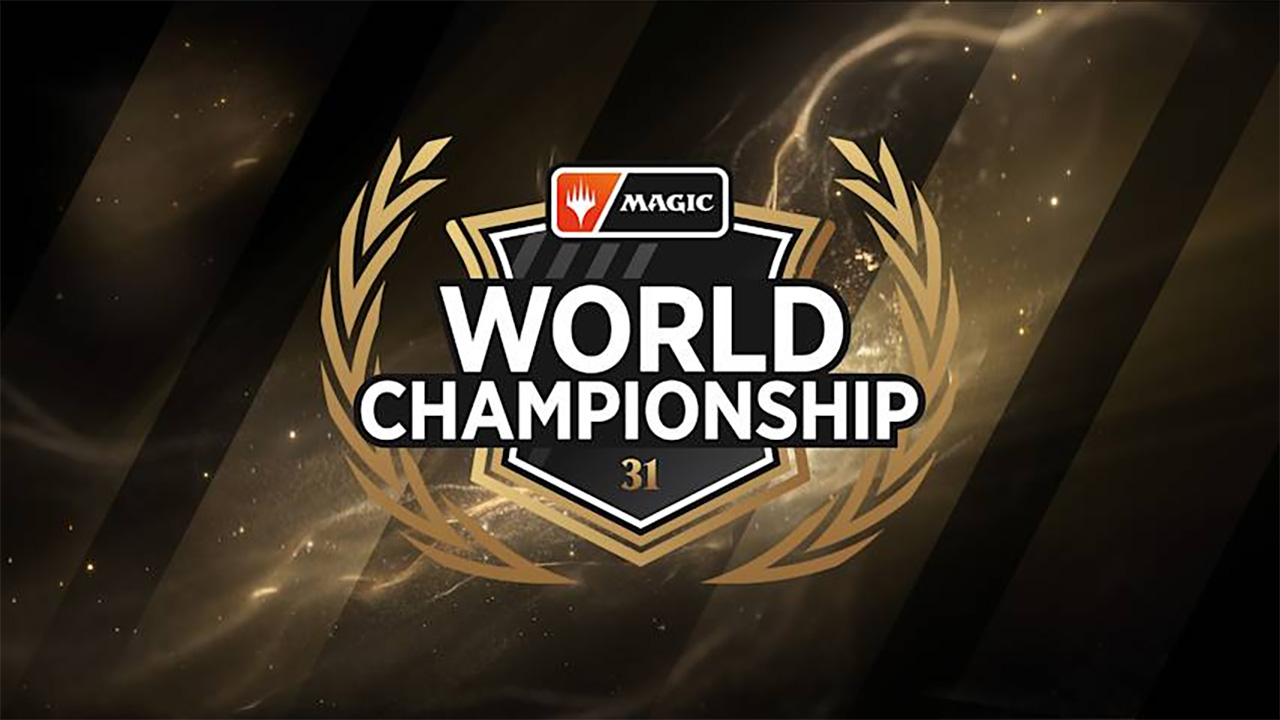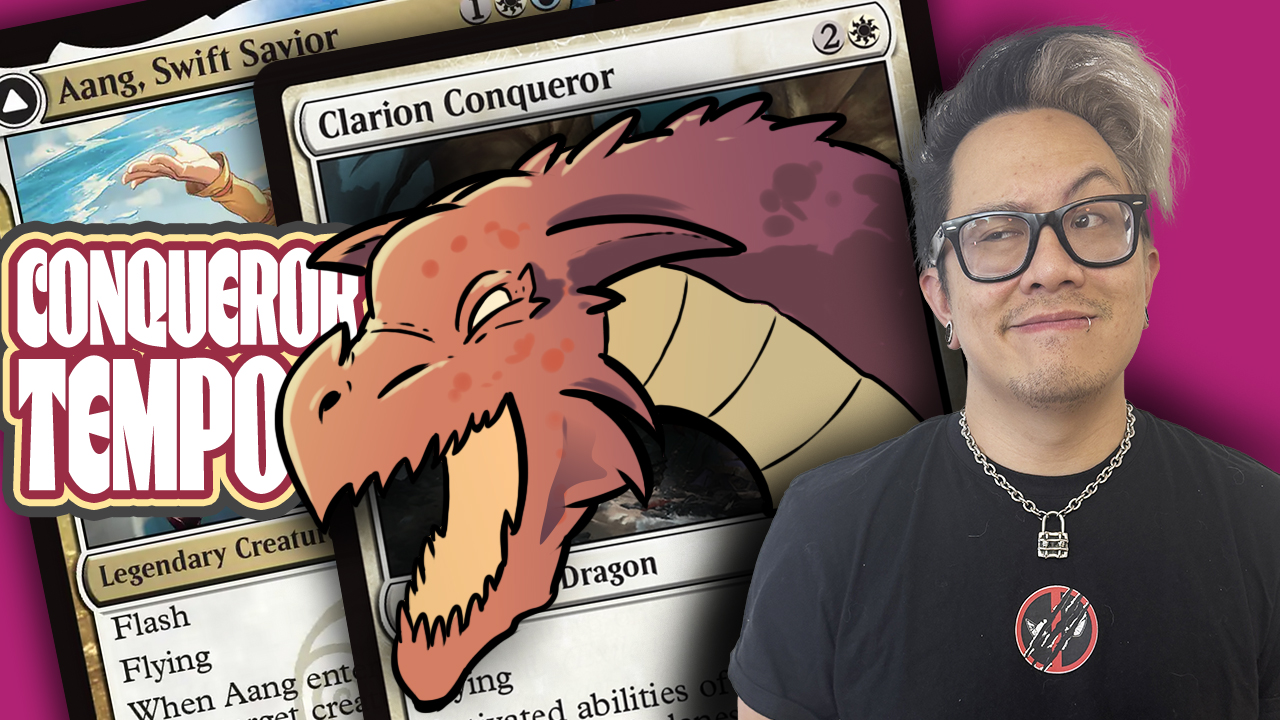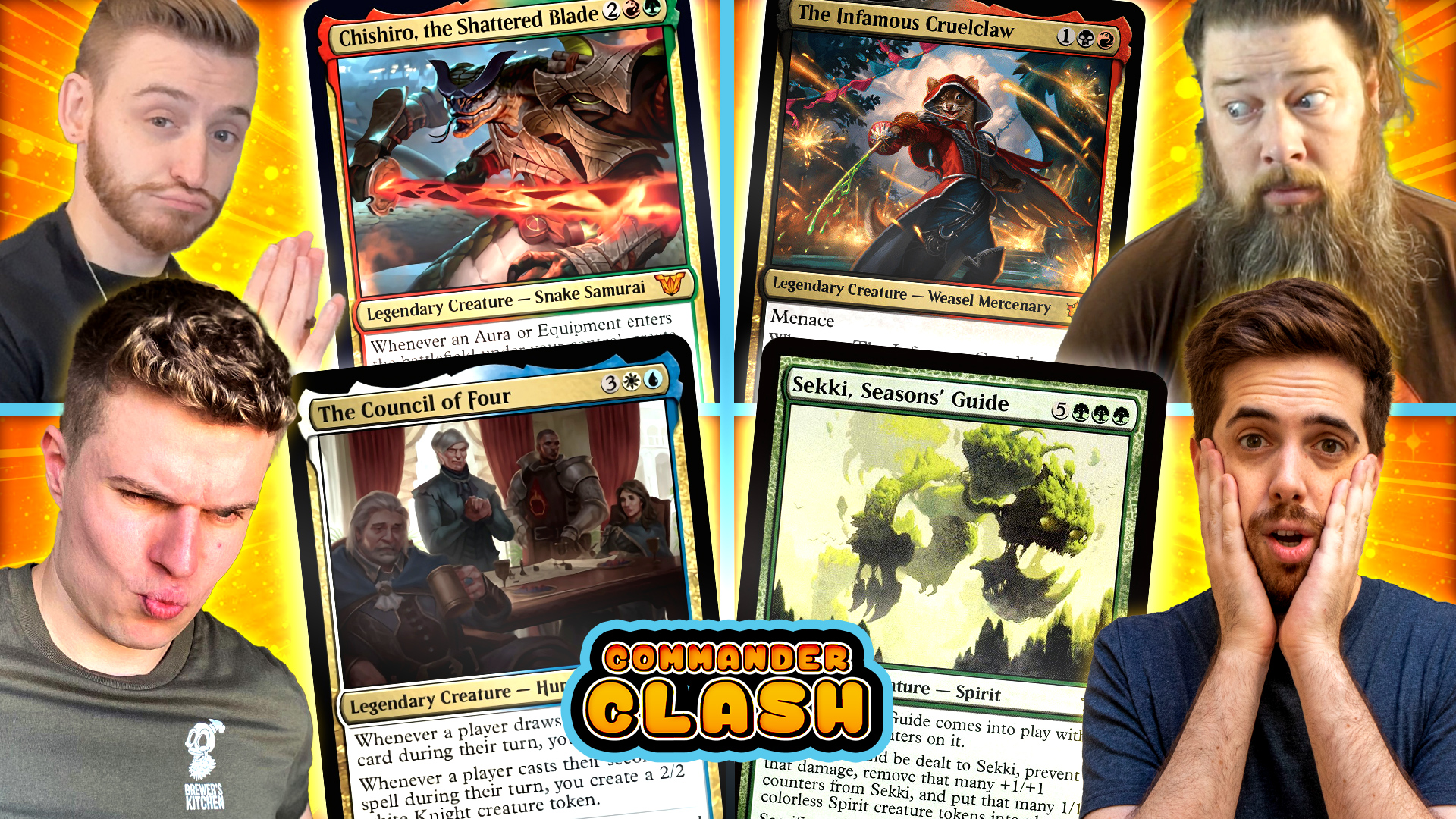2020 Challenger Decks: Rankings and Ratings
A couple of months ago, Wizards promised that the Challenger Deck series—a group of Standard preconstructed decks based on tournament-worthy decks and designed to be playable at events like Friday Night Magic right out of the box—would be returning in April 2020, but we didn't know the themes of the decks or what cards they would contain. Then, this past weekend at Worlds, Wizards released the decklists for the series. While each has a fun name, they are basically Fires Friends (Fires of Invention with planeswalkers, named Allied Fires), GB Adventures (a mixture of Knights and Adventure synergies going by Final Adventure), Mono-Red Cavalcade (Mono-Red Aggro built around Torbran, Thane of Red Fell and Cavalcade of Calamity, called Cavalcade Charge), and Simic Flash (named Flash of Ferocity).

As I mentioned a moment ago, the idea of Challenger Decks is that you can play the decks semi-competitively at events like Friday Night Magic right out of the box while also having some amount of upgrade potential into legitimate top-tier archetypes. Based purely on the decks' current value (and assuming they sell for somewhere in the $30 range, which is no longer a given thanks to the end of MSRP), all of the decks are a fine deal from a financial perspective, but which one is best overall? That's what we're going to try to figure out today by ranking the decks based on five criteria, as we have done with past editions of Challenger Decks (for comparison, you'll find the 2019 Challenger Deck article here). Of course, when it comes to actually buying a Challenger Deck, your playstyle will play heavily into which one you choose, but hopefully, our breakdown will give you a look at the strengths and weaknesses of the 2020 Challenger Deck series as a whole. But before we start rating and ranking, let's look at the decks!
Oh yeah, one last thing: for the rest of the article, we'll be calling the decks by their archetype names (Simic Flash, GB Adventures, Fires Friends, and Mono-Red Aggro) rather than the names actually printed on the box since the archetype names are more intuitive and will hopefully save you from having to jump back and forth to the decklists a bunch of times to figure out what deck we're talking about.
The Decks

Fires Friends is basically a planeswalker control deck. The idea is to keep the board clear with cards like Deafening Clarion and Time Wipe, play a bunch of planeswalkers that generate card advantage, eventually stick a Fires of Invention to allow us to cast our spells for free (and spend our mana activating Kenrith, the Returned King or scrying with Omen of the Sea), and overwhelm our opponent with planeswalker value and even planeswalker attacks with the help of Sarkhan the Masterless. From a competitive perspective, this deck was somewhat popular right after Throne of Eldraine was released but has since fallen out of favor, with the Cavalier of Gales / Cavalier of Flame build becoming the Fires of Invention deck of choice for tournament tables.

GB Adventures is one of my personal favorite decks. A few months ago, we played essentially the same deck (calling it Lucky Knights) to Mythic on Magic Arena. While GB Adventures might look like an aggro deck, it's really a combo deck looking to grind out value with adventure cards and eventually win the game by filling the board with Knights, having a few Lucky Clovers on the battlefield, and draining the opponent out of the game with the help of Smitten Swordmaster.

Mono-Red Aggro is currently one of the top decks in Standard, although there are a couple of key differences between the Challenger Deck build and the top tier build, with the biggest being that the Challenger Deck version of Mono-Red Aggro is built around Cavalcade of Calamity (and a bunch of one-power creatures to trigger it), while the tier build is built around Anax, Hardened in the Forge and Embercleave, allowing for one huge, potentially game-ending attack with a massive, trampling, double-striking creature. The Cavalcade of Calamity build of Mono-Red was more popular before the printing of Theros: Beyond Death released Anax, Hardened in the Forge into the format.

Simic Flash is basically the control deck of this year's Challenger Deck series. The idea is to basically never tap mana on your own turn, instead leaving up all of your resources during your opponent's turn, which will allow you to counter your opponent's plan if you need to. And if you don't need to counter anything, you can flash a threat like Wildborn Preserver, Brineborn Cutthroat, or Nightpack Ambusher onto the battlefield. While Simic Flash isn't a top-tier archetype at the moment, it does still see play in Standard, and the Challenger Deck looks very much like the top-tier builds of the deck, with a few exceptions.
The Rankings
Best Current Value
| Rank | Deck | Price |
| #1 | Mono-Red Aggro | $111 |
| #2 | Simic Flash | $105 |
| #3 | GB Adventures | $96 |
| #4 | Fires Friends | $75 |
This category is pretty simple since it's just looking at the total value of the cards in each deck. Mono-Red Aggro comes out the winner based on a copy of Embercleave, which is about $25 all by itself, as well as playset each of Bonecrusher Giant, Torbran, Thane of Red Fell, and Light Up the Stage, which each cost in the $12–15 range, although Simic Flash and GB Adventures aren't that far behind. The only deck that isn't great from a value perspective is Fires Friends, which lags $20 or $30 behind the other decks in the series.
From a more meta perspective, it seems like the 2020 Challenger Decks are at least somewhat juiced value-wise compared to the 2019 decks. Last year, one deck had a value of $117, and none of the other decks in the series were worth more than $75, giving the decks an average value of $79 (although this was brought to you by the one very valuable deck). Meanwhile, the 2020 Challenger Decks have an average value of $97, a 19% increase over last year's offering. More importantly, the value is much more evenly distributed throughout the decks. Fires Friends—the least valuable 2020 Challenger Deck—would have been tied for second most valuable if it had been printed in 2019.
Most Chase Cards

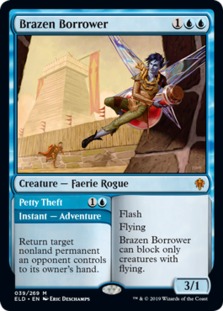


| Rank | Deck | Cards | Total "Chase" Value |
| #1 | GB Adventures | Knight of the Ebon Legion (x2), Murderous Rider (x2), Vraska, Golgari Queen (x1), Castle Locthwain (x2), Fabled Passage (x1) | $67.45 |
| #2 | Simic Flash | Brazen Borrower (x1), Fabled Passage (x1), Aether Gust (x3), Mystical Dispute (x2) | $59.36 |
| #3 | Mono-Red Aggro | Embercleave (x1), Light up the Stage (x4) | $37.03 |
| #4 | Fires Friends | Kenrith, the Returned King (x1), Steam Vents (x1), Narset, Parter of Veils (x4) | $29.48 |
"Chase" is a fairly subjective designation, but we're going to define chase as "worth more than $5" for rares and mythics and "worth more than $2.50" for uncommons and commons, which is the same definition of "chase" we used in previous years. Here, things break down fairly cleanly, with GB Adventures and Simic Flash pacing the field, mostly thanks to Fabled Passage in the mana base, while Mono-Red Aggro and Fires Friends lag behind.



It is worth mentioning that Mono-Red Aggro gets somewhat unlucky based on our criterion of chase, with a bunch of different cards that do have value but fall just short of our cutoff, with Chandra, Acolyte of Flame being the most obvious, with a retail price of $4.98 per copy, while both Bonecrusher Giant and Torbran, Thane of Red Fell are in the $3.50 range, and you get four copies of each in the deck. On the other hand, these are the type of cards that often lose the most value from being reprinted in something like a Challenger Deck, while the most valuable cards in the set (especially the ones that only come as one-ofs, like Embercleave, Brazen Borrower, Fabled Passage, and Steam Vents, have a better chance at holding their value.
Best Long-Term Value
Long-term value is concerned with two things: cards that survive the next Standard rotation and cards that see play in older formats like Pioneer, Modern, and Commander. In the past, some of the most valuable cards in Challenger Decks are ones that will be rotating from Standard a few months after the decks are released, which means that while they do have immediate value, they are likely to steeply decline in price in the near future unless they see play in other formats. Which of the 2020 Challenger Decks include cards that will likely remain valuable for longer than just a few months?



| Rank | Deck | Cards |
| #1 | GB Adventures | Murderous Rider (survives rotation, Pioneer staple), Castle Locthwain (survives rotation, Pioneer staple), Knight of the Ebon Legion (Pioneer play), Lovestruck Beast (survives rotation, Pioneer play). Fabled Passage (survives rotation, Pioneer / Commander staple). |
| #2 | Simic Flash | Fabled Passage (survives rotation, Pioneer / Commander staple), Castle Vantress (survives rotation, Pioneer / Modern play), Brazen Borrower (survives rotation, Pioneer / Modern play), Mystical Dispute (survives rotation, Pioneer / Modern staple). |
| #3 | Mono-Red Aggro | Embercleave (survives rotation, Pioneer play), Bonecrusher Giant (survives rotation, Pioneer play), Castle Embereth (survives rotation, Pioneer play), Light Up the Stage (Modern / Pioneer staple) |
| #4 | Fires Friends | Kenrith, the Returned King (survives rotation, Commander staple), Narset, Parter of Veils (Commander / Modern / Pioneer staple), Fires of Invention (survives rotation), Steam Vents (Commander / Modern / Pioneer ultra-staple), Ashiok, Dream Render (Pioneer / Modern / Commander play). |
In general, Wizards did a much better job this year of including cards that will maintain some amount of value after the next Standard rotation in basically all of the Challenger Decks. GB Adventures tops our list of best long-term value for one important reason: almost the entire deck survives rotation, so unlike Simic Flash and Fires Friends (which mostly die at rotation) as well as Mono-Red Aggro (which will need to adapt at rotation), if you buy the GB Adventure deck, you're not just getting a deck you can play from April to September but also one you can play for nearly a year and a half in Standard, which is a pretty big deal for players looking to compete in Standard without spending a ton of money.
Discounting the decks' playability, the Simic Flash deck might be the best long-term value in terms of individual cards. Fabled Passage and Brazen Borrower are both staples in the Pioneer format, and even though you're only getting one copy of each, just those two cards are worth more than the entire cost of the Simic Flash Challenger Deck. Meanwhile, Mono-Red Aggro gets a boost thanks to Embercleave remaining in Standard for another year, while Fires Friends again comes in at the bottom of our list. While Steam Vents is perhaps the single most played card in the 2020 Challenger Decks, it is rotating from Standard in the fall, so it loses some value if you don't play Pioneer, Commander, or Modern (although you'll always be able to sell or trade it for a decent price), while the rest of the good long-term cards from the Fires Friends deck are uncommon planeswalkers that aren't really all that expensive and will probably be even less so once the new supply from the Challenger Decks hits the market.



One other thing I wanted to mention is that if you need copies of some of the chase cards in the Challenger 2020 decks (like Embercleave, Brazen Borrower and Fabled Passage), buying multiple copies of the deck is a very legitimate plan. Let's say you don't really care all that much about playing Simic Flash but you do want Brazen Borrower to play Esper Control or Jeskai Fires. Rather than buying four copies of Brazen Borrower as singles on the market, you'll come out ahead buying four copies of the Simic Flash Challenger Deck, using the Brazen Borrowers (and any other cards you need for your collection) and then selling or trading away the cards you don't need. The same is true of Embercleave and Fabled Passage.
Most Playable Out of the Box
| Rank | Deck |
| #1 | Mono-Red Aggro |
| #2 | Simic Flash |
| #3 | Fires Friends |
| #4 | GB Adventures |



In ranking the out-of-the-box playability of the 2020 Challenger Decks, the goal is to be as objective as possible by comparing the decks from the series to decks that have been performing well in recent Standard tournaments. Here, Mono-Red Aggro is head and shoulders above the rest of the offerings. While the Challenger Deck build of Mono-Red Aggro has a few key differences with the tier build of Mono-Red Aggro (which is currently one of the top three decks in Standard)—namely, the lack of Anax, Hardened in the Forge and only a single copy of Embercleave—if you buy the Mono-Red Aggro Challenger Deck, you're getting a decent chunk of one of the best decks in Standard for a low price.


In second place is Simic Flash, which isn't a top-tier Standard deck at this point but is competitive and occasionally posts strong results at tournaments. Apart from missing three copies of Brazen Borrower and having a clunky mana base without Breeding Pool, the Challenger Deck list is actually very close to the optimal build of the deck. While Simic Flash isn't one of the best decks in Standard by any stretch, it is playable, and you could certainly play the Simic Flash Challenger Deck right out of the box at a Friday Night Magic–level event and have success with it.

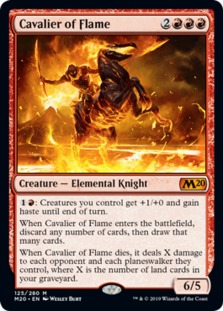

At the bottom of our list are GB Adventures and Fires Friends, which are essentially tied in last place. Being in last place doesn't mean these decks are bad—they still have powerful cards and a solid game plan—but they were near the top of the format a few months ago, but thanks to shifts in the metagame and the release of Theros: Beyond Death, both decks have fallen out of favor in terms of competitive play. GB Adventures thrived during the height of the Oko, Thief of Crowns meta because it's great at grinding out long-game value, but it struggles with the huge bursts of damage from decks like Jeskai Fires and Temur Reclamation, which are currently among the most played in the format. Meanwhile, Fires Friends has mostly fallen out of favor because the Cavalier of Flame / Cavalier of Gales / Kenrith, the Returned King version of Fires of Invention is so powerful. The planeswalker version of the deck is fine; it just isn't as good as the Cavalier version, and tournament players tend to gravitate toward the best version of a given archetype.
Easiest to Upgrade
| Rank | Deck |
| #1 | Mono-Red Aggro |
| #2 | Simic Flash |
| #3 | GB Adventures |
| #4 | Fires Friends |

Mono-Red Aggro is by far the easiest 2020 Challenger Deck to upgrade into the fully powered optimal version of the deck. You're basically missing two semi-expensive cards and one key (but cheap) uncommon. To play the fully powered version of Mono-Red Aggro, you drop Cavalcade of Calamity for three more copies of Embercleave and add Robber of the Rich to your creature base. The only issue is that three copies of Embercleave are currently $75, while Robber of the Rich is $17 for a playset.
This means there are basically two pathways to upgrading the Mono-Red Aggro Challenger Deck. The first is to buy a copy of the Challenger Deck and then spend about $100 to pick up the missing pieces for the tier build, giving you the fully powered deck for about $140 (compared to the $180 price tag if you bought it without the help of the Challenger Deck). The second is to pick up four copies of the Challenger Deck, using the three extras primarily for their Embercleaves, and then buy four copies of Robber of the Rich for about $17. This plan will cost about $180–200 upfront; however, it costs less in the long run if you trade or sell cards because thanks to the three extra copies of the deck, you'll have 12 extra copies of Bonecrusher Giant (total value around $40), 12 extra Torbran, Thane of Red Fell (total value around $40), and 12 extra copies of Light Up the Stage (total value about $36) along with a bunch of semi-valuable cards like Fervent Champion, Castle Embereth, and Runaway Steam-Kin, all of which are around $2 per copy at the moment. If you can trade or sell your extras for a reasonable price, the "buy four copies of the deck" method will get you tier Mono-Red Aggro for the cheapest possible price (potentially as little as $75 when all is said and done), but it will take some amount of work to trade or sell the extra cards.

Simic Flash is also fairly easy to upgrade, although the end result is a second- or third-tier deck rather than a top-tier deck like Mono-Red Aggro. The creature base of the Simic Flash Challenger Deck is very close to the optimal build of the deck, minus a couple of extra copies of Brazen Borrower, which can replace Wavebreak Hippocamp, and a copy of Spectral Sailor or Wildborn Preserver, while the spells are cheap to upgrade since they are mostly random common and uncommon counterspells. The most expensive part of the upgrade is the mana base. Simic Flash doesn't want too many tapped lands because it really wants to be able to play its spells on curve and eventually play multiple things in a turn (like countering a spell and playing a creature), which means that dropping Thornwood Falls for Breeding Pool is essential, although just four copies of Breeding Pool will set you back somewhere around $80.
While you could try to use the same trick as with upgrading Mono-Red Aggro and buy extra copies of the deck to get more copies of Brazen Borrower and more copies of Fabled Passage, the problem is that you're still going to need to spend $80 on Breeding Pool no matter how many copies of the Challenger Deck you buy. In theory, you might be able to use some of your extras to trade for the Breeding Pools, but it will probably be hard to find someone willing to trade a staple shock land for Temple of Mystery, Shifting Ceratops, and Aether Gust. Still, since Simic Flash is one of the higher-value decks from the series, buying multiple copies to get a playset of Brazen Borrower and Fabled Passage is still a very reasonable plan from a financial perspective.

The downside of GB Adventures is that it hasn't been very strong since Theros: Beyond Death was released. The upside is that it's actually fairly cheap to upgrade into the optimal version of the deck. The creatures in the Challenger Deck are mostly on point, minus a couple of extra copies of Murderous Rider and Lovestruck Beast, while the main expense is improving the mana base with a playset of Overgrown Tomb (which thankfully is one of the cheaper shock lands, at only $46 for all four copies). Assassin's Trophy is a nice addition to the sideboard, but it isn't 100% necessary if you are trying to upgrade on the cheap, and the same is mostly true of Leyline of the Void (which is probably no longer optimal now that Rakdos / Jund Sacrifice is on the downswing).
When it comes to upgrading GB Adventures, the correct number of Challenger Decks to buy is probably two. If you buy two copies, you'll get a full playset of Murderous Rider (one of the important upgrade pieces) along with more copies of Castle Locthwain and Fabled Passage, which you can either play in the deck or try to trade for the Overgrown Tombs needed to complete the upgrade of the deck.

My advice on Fires Friends is that it isn't really worth upgrading. The deck hasn't proven itself to be very good since the release of Theros: Beyond Death, and the upgrade is very expensive. You need four copies of Teferi, Time Raveler ($88), a bunch of shock lands and Fabled Passages (total cost about $140), and potentially another $40 worth of sideboard cards. All together, upgrading to the optimal list of Fires Friends will cost you close to $300, and the end result is a deck that isn't really all that good for tournament play anyway.
While it might be tempting to try to buy the Fires Friends list and drop the planeswalkers to play Jeskai Fires (which is a top-tier deck in Standard), apart from Fires of Invention, Kenrith, the Returned King, Deafening Clarion, and one copy of Steam Vents, none of the cards from the Challenger Deck actually show up in Jeskai Fires. As a result, if you want to play Jeskai Fires, there isn't enough cross-over between the tier build and the Challenger Deck to make it worth trying to upgrade. You're better of just buying Jeskai Fires from scratch.
Final Rankings and Thoughts
We ranked each 2020 Challenger Deck in five categories based on value and gameplay. A first-place finish in a category is worth four points, scaling down to one point for a last-place finish. This means that the maximum number of points a deck can earn is 20 (which would be first place in every single category), while the minimum is four points (last place in every category). Here's where the decks finished.
- Mono-Red Aggro: 16 points
- Simic Flash: 15 points
- GB Adventures: 13 points
- Fires Friends: 6 points
In the end, the 2020 Challenger Decks basically have two very good offerings (Mono-Red Aggro and Simic Flash), one solid offering (GB Adventures), and one really weak deck (Fires Friends). The good news is that all of the decks in the series are worth their price tag (assuming they again cost somewhere around $30, which again isn't guaranteed since there is no longer an MSRP), so it isn't so much that you shouldn't buy Fires Friends (even though it is the worst-rated Challenger Deck in the history of the series); it's more than the other decks offer more value (either in terms of financial value or gameplay value) than Fires Friends does for most players. Basically, these rankings are designed to give you some additional things to think about when making your Challenger Deck purchase and are not designed to be taken as the gospel truth since which deck is right for you also depends on your playstyle and definition of fun, which is impossible for others to rate and rank from the outside. Anyway, let's wrap up with some final thoughts and advice on each deck.
- Mono-Red Aggro: The big winner this year is Mono-Red Aggro, mostly because it seems to be the best deck out of the box and also the cheapest and easiest to upgrade into a legitimate top-tier Standard deck. If you want to sit down at an FNM and have the best shot of winning with a Challenger Deck, this is very likely the deck for you. If your goal is to make the upgrade and you don't mind some trading or buylisting, consider buying four copies of the deck to get your playset of Embercleave (which is essential for making the deck truly competitive) and then selling or trading away the extra copies of cards like Bonecrusher Giant, Light Up the Stage, and Chandra, Acolyte of Flame to recoup some value.
- Simic Flash: Simic Flash managed to be decent basically across the board. While not as good as Mono-Red in terms of playability, it did come in second to Mono-Red in most of the gameplay-centric categories, while also getting high marks for value thanks to Fabled Passage and Brazen Borrower - two of the three most expensive cards among all of the 2020 Challenger Decks. Having two expensive cards that see heavy play outside of Standard (and survive rotation) make Simic Flash an easy deck to buy from a financial perspective. Even if you aren't all that interested in playing with Simic Flash, getting a Brazen Borrower, Fabled Passage and a bunch of other cards for $30-$40 is a very solid deal both short term and long term.
- GB Adventures: The biggest advantage of the GB Adventure deck is that it is the one Challenger Deck most likely to survive rotation, which makes it the perfect option for players looking to stretch their Standard budget not just over the next few months but over the next year and a half. Even though the deck isn't in a great place competitively at the moment, it is powerful, and there is certainly a chance that something similar will re-emerge as a top-tier strategy at some point during the next 18 months while the deck remains legal in Standard. Basically, while GB Adventures might not be the best Challenger Deck right now, there's a decent chance it will be after rotation comes in September. While the rest of the decks will mostly fade away as key cards leave the format, GB Adventures will keep on drawing cards and draining opponents out of the game with Smitten Swordmaster and Lucky Clover.
- Fires Friends: There really isn't much good to say about Fires Friends. It doesn't have especially high value compared to the other decks in the series. It isn't especially playable. The planeswalkers it is built around all rotate from Standard in the fall. Basically, I think it's fair to consider this deck a miss from Wizards. When you consider that Simic Flash got a copy of Brazen Borrower and Mono-Red Aggro got a copy of Embercleave, it's pretty disappointing that Wizards didn't include one copy of Teferi, Time Raveler in the Fires Friends deck. It is the most played planeswalker in the archetype and would have bumped the deck's value up into the range of the other 2020 Challenger Decks. You should buy whatever Challenger Deck you will have the most fun with, but my advice is to avoid Fires Friends unless you really like the playstyle of the deck. It just doesn't have much going for it on any level.
Conclusion
Anyway, that's all for today. What do you think of the 2020 Challenger Decks? Do you agree with these rankings? Disagree? Which decks are you planning to buy? Let me know in the comments! As always, leave your thoughts, ideas, opinions, and suggestions in the comments, and you can reach me on Twitter @SaffronOlive or at SaffronOlive@MTGGoldfish.com.


